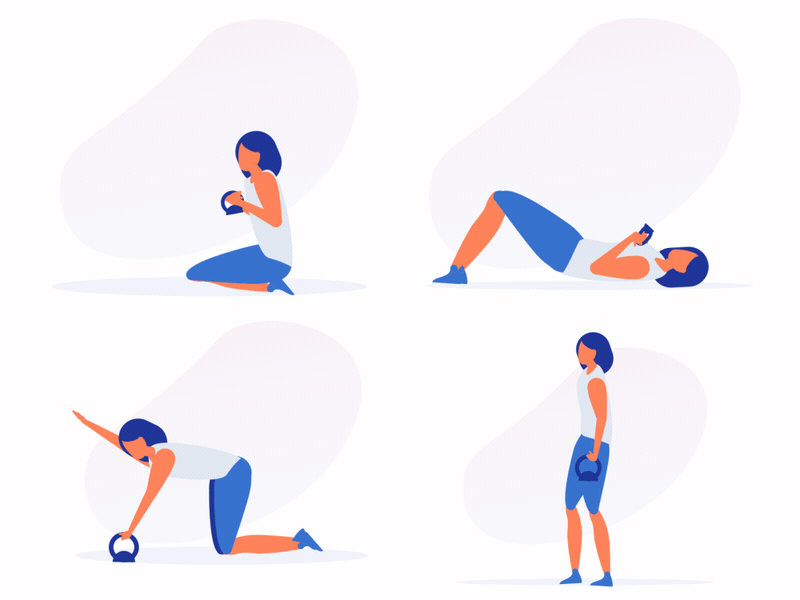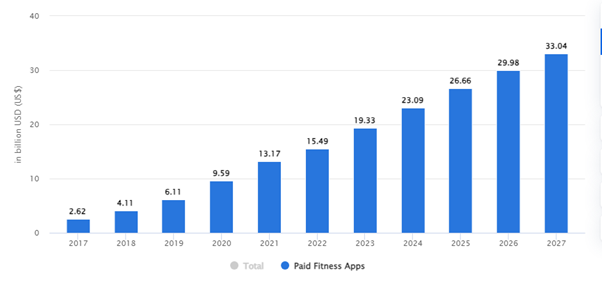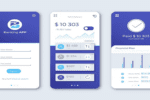“To keep the body in good health is a duty… otherwise, we shall not be able to keep the mind strong and clear.”
– Buddha
How much does it cost to build a fitness app? It’s a multi-million-dollar question! Undoubtedly, one of your initial inquiries when attempting to determine how to start an online fitness business. Additionally, looking into the usual cost of developing an app is useless. Why? Because many other factors will influence the overall cost of building a fitness app.
To say that the fitness industry is flourishing would be an understatement. Global fitness clubs are valued at $70 Billion, and the global fitness apps market is estimated to be worth $1.21 Billion.
By 2030, this industry is expected to grow to $5.41 bn. Numerous businesses seek for a mobile app development company that can turn out an excellent product affordably.
In light of the above background, it is important to explore the various factors that impact the cost of creating a fitness app.
To know the cost to build a fitness app, you must first determine its type, choose its main features, and estimate how long each feature will take to be developed. Combining all the factors makes it possible to estimate how much a fitness application will cost.
What is a Fitness App?

Mobile applications help individuals monitor their fitness levels, improve their exercise routines, and achieve overall wellness and health goals.
These apps offer workout tracking, exercise library, nutrition tracking, and goal setting. Additionally, they interact with wearable technology that records information like steps, heart rate, and sleep habits.
The cost to build a fitness app will increase when you design to give users personalized workout plans, nutrition and diet guidance, motivation, and a platform for connecting with other like-minded people to support them and hold them accountable.
These apps are intended to help individuals stay motivated and committed to their fitness journey, achieving their desired health outcomes.
Fitness App: Fascinating Facts & Stats

- The Fitness Apps segment revenue is expected to reach US$19.33bn by 2023.
- Sales revenue is predicted to increase at a rate of 14.34% annually (CAGR from 2023 to 2027), producing a market size of $33.04 billion.
- In 2022, the market for fitness applications was estimated to be worth USD 1.5 billion. It is anticipated to expand between 2023 and 2030 at a CAGR of 17.6%.
- 2023 the user penetration rate is projected to be 9.76% and reach 12.21% in 2027.
- The anticipated amount, or average revenue per user (ARPU), is pegged at US$25.78.
- China will generate the largest revenue (US$5,457.00m) in global comparison.
- MyFitnessPal, the top fitness and sports mobile app in March 2023, generated revenues from within-app of nearly 12 million U.S. Dollars. Strava was ranked second with combined revenues of approximately 7.31 million U.S. Dollars via Google Play Store and Apple AppStore.
How Does Fitness App Work?
A fitness app works by leveraging the capabilities of smartphones and wearable devices to help users track and improve their fitness levels. The app typically starts with a user registration and profile creation process, where individuals input their personal details, fitness goals, and preferences.
Once registered, users can access a range of features offered by the app. These may include workout tracking, where users can log their exercise sessions and record the type of activity, duration, and intensity. The app may provide pre-built exercise libraries or allow users to create custom workouts.
Fitness applications frequently have food tracking features that let customers register their everyday dietary habits and keep records of calories. They may offer access to a comprehensive nutrition database to easily search and log food items.
Goal setting and progress monitoring are crucial components of fitness apps. Users can select particular exercise objectives, including gaining muscle, losing weight, or improving their cardiovascular endurance. The app tracks their progress over time, providing insights, charts, and visual representations of their achievements.
However, an on-demand app development company plays a significant role in creating on-demand fitness apps. They utilize technologies like app development frameworks, APIs, and backend infrastructure to build the app’s features, user interface, and data management capabilities. They ensure the app is user-friendly, secure, and compatible across mobile platforms like iOS and Android.
Market Leaders of the Fitness App Industry
| Fitness App | Available Platform | Ratings | Downloads |
| MyFitnessPal | Android | iOS | 4.1 | 100M+ |
| Apple Fitness+ | iOS | 3.5 | 10M+ |
| Jefit | Android | iOS | 4.5 | 5M+ |
| Google Fit | Android | iOS | 4.0 | 100M+ |
| 8Fit | Android | iOS | 4.4 | 10M+ |
1. MyFitnessPal
The original calorie-counting app is MyFitnessPal, which was released in 2005. This program provides users with a basic set of tools to manage their daily intake of calories and nutrients together with the calories they expend by breathing, moving, and working out. It is based on the uncomplicated concept of calories-in-calories-out.
Users of MyFitnessPal can search through the vast database to catalog their meals. Users can manually enter information if a food item is not included in the database. When customers scan the QR codes on tags on cooked food, if the company’s name already exists in the records, the fields will be filled in immediately. Only the number of servings has to be updated by the consumer.
2. Apple Fitness+
Apple Fitness+, the paid fitness application, is free for 3 months after purchasing an Apple Watch. Apple Fitness+ has the obvious advantage of being one of the best Apple Watch Fitness applications, as it was designed specifically for the device.
Apple Fitness+ is a fitness software that syncs easily with Apple Watch to measure heart rate, steps, and other vitals. So, if you want to develop an app like Apple Fitness+, you must hire on-demand app developers.
Along with various routines, Apple Fitness+ Plus now provides Pilates, Strength Training, and Yoga. The program also offers weekly exercises and guided meditations. Mind and bodily health are interdependent.
3. Jefit
Weightlifting is the focus of Jefit, which experts call resistance training. It allows users to track cardio and weight training but excels at the weight-lifting part. Users looking for a full-body workout can search in the app based on which major muscle groups they want to work.
All the relevant exercises will appear when they search for them. The user may learn the right form for several strength training activities. Whether you have a high-end gym or only a few dumbbells, it makes no difference. They can work out using only their bodies, performing various variations of crunches, press-ups, etc.
4. Google Fit
Google Fit is a truly amazing product. It may seem like another fitness application (good for tracking workouts and activities). It is unique because it can be integrated with an incredible number of apps and devices. Why is this crucial?
All of your fitness equipment and applications are linked via Google Fit. Say, for example, that you use MyFitnessPal as a food tracker, an Apple Watch as a step tracker, and Jefit to track weight training. Google Fit compiles all of this information in one location for your inspection.
5. 8Fit
8Fit, a free app with a subscription feature, focuses on sustainable health. It goes beyond only being large, buff, and shredded. 8Fit has a wide range of workouts you can do at home and meal plans and recipes you can customize.
It also offers guided meditations pre-recorded. If you also want to integrate pre-recorded meditation functionality, hire mobile app developers. The website also provides a substantial collection of content divided into the following four distinct groups: fitness, recipes, and lifestyle.
Factors Affecting the Cost to Build a Fitness App

Now that you have known the features that are essential for the app functionality, we will now discuss the factors that affect the cost to build a fitness app. So, let’s have a look:
The App Development Approach- iOS/Android/Cross-Platform
The cost to build a fitness app depends on which development method you select. Android and iOS both make great platforms for creating fitness applications. If you’re looking to design a unique fitness application for the fitness business, another choice is cross-platform app development.
The costs of developing an app for a single platform are higher than those of creating a multi-platform app. The platform you choose depends on your target market, its needs, what type of app you’re developing, and what features you want.
UI/UX Design Needed for Your Fitness Mobile App
Users should be engaged by the aesthetics of fitness applications, which should be aesthetically appealing. Because Snapchat is so aesthetically pleasing and has so many features, businesses and entrepreneurs are curious about the cost to build a fitness app identical to it. A user-friendly fitness application may be made using the vibrant colors, animations, and other design components seen in Snapchat.
The cost of a mobile application may be significantly influenced by its design. App designers may need more time if they have to create complex screens and detailed designs. The prototype development cost is different from the visual design costs.
Features to Integrate into Fitness App Development
The basic fitness app is less expensive than the advanced wellness apps that use current technology. App features can affect the price of an application. We will talk about the features of popular fitness apps, how long it takes fitness app development, and their impact on the cost.
If you want to include advanced features such as tracking activity levels, monitoring your heart rate while exercising, or personalized workout recommendations, you must integrate HealthKit into your fitness application. It could increase development costs and time, especially if custom data analysis or visualization is needed.
Fitness App Development Prices by Country
The hourly rate for each country will determine the cost. In countries such as the USA, hourly rates for developers are higher. When you hire a dedicated team of developers from different countries, the cost will automatically fluctuate. It does not remain the same. Here is the table that defines the hourly cost of developers from different locations.
| Country | Developer Hourly Rates |
| US | $70 |
| Australia | $70 |
| Asia | $25 |
| Canada | $65 |
| Western Europe | $63 |
| Eastern Europe | $56 |
| Latin America | $51 |
| Africa | $50 |
Hiring Method (In-House or outsourced)
The cost of developing a fitness app depends on how you hire. Costs of developing fitness apps in-house may be slightly higher than outsourcing costs. The approach chosen can affect the overall budget and cost to build a fitness app solution. The cost of creating a solution will depend on a number of things.
- Hiring costs: Total cost of hiring, including screening and skimming through resumes to find the right team.
- Salaries: You need to pay salaries for in-house app developers. Outsourcing app development means you only pay for services.
- Infrastructure: Outsourcing infrastructure means you do not need to spend money on it. You must invest in the I.T. infrastructure, applications, and resources while building your app internally. Contact a fitness app development firm to find out the price of your app.
- Project Management: Both cases require hiring a project manager and investing in tools that ensure smooth and controlled development.
How Much Does It Cost to Build a Fitness App?
You should always budget for app updates and maintenance. Budget for the many changes that will be needed to an app in the future. Version control and app maintenance fees should be roughly 15% to 20% of the total.
The characteristics for each of these app kinds are covered in the table below, which is followed by the cost to build a fitness app:
| Fitness App Types | Must-have Features | Final Cost of Development |
| Simple App (Basic Features) | Registration
Goal Setting Activity Tracking Sleep Tracking Push Notifications Social Media Integration In-app payments Multiple device synchronization |
$8,000 – $15,000 |
| Medium-App(Slightly Advanced Features) |
All the basic level features + Workout routines In-app Purchases Geo Location Video Tutorials Security Protocols Integrating wearable devices Online consultation |
$15,000 – $20,000 |
| Complex | All basic and medium level features +
AI-driven personal coach Gamification Live streaming Video-on-demand |
$20,000 – $25000 |
Depending on the features, a basic fitness app can cost between $8,000 and $15,000. If you want a more advanced solution, it could cost up to $25,000 or even more, depending on the features.
However, the cost to build a fitness app will increase if you decide to create mobile fitness applications using artificial intelligence and other cutting-edge tools.
You must work with devoted developers that have experience creating fitness app solutions. You will also want skilled programmers capable of starting from scratch to construct a fitness app.
Must-Have Features to Integrate into Fitness App

The features of a fitness application and its monetization strategy are closely related. Fitness apps are more appealing because they have interesting features. When you integrate these features, the cost to build a fitness app will be increased.
1) Sign Up & log In
It is essential to have the option of creating a personal account before you go any further. Signing up with social media credentials is a must. Users can also create an account by email.
2) Physical Conditions Tracking
Track user activities such as the number of steps taken, sleep duration, and arterial pressure. Tracking features can be implemented without requiring external devices such as wearables.
3) Diet Features
Any app would benefit from including the diet option. This can be a complimentary feature. It can give your service a boost compared to others. You can offer the most basic version of tracking diets for free and charge for more customized plans.
4) Community Building
Fitness enthusiasts can benefit from features that encourage community building. This would, in turn, help to keep users motivated and engaged. Therefore, the cost to design a fitness app will rise as soon as you include these functionalities.
5) Integration of Music Apps
You may combine the application with well-known music applications. It can also play playlists specific to workouts, making it easier for you to exercise. This makes exercising more enjoyable without the need to fiddle with external sources.
6) Wearable Device Integration
Wearable integration is beneficial for any app. Wearables and fitness apps can increase the value of an app. So when you hire on-demand app developers, ask them to add functionality like wearable device connectivity with the app. The app will also encourage users to use it more often.
7) Workouts with Professionally Trained Trainers
Your app can also offer training from popular and professionally-trained coaches. Apple Fitness+, a home workout program for Apple Watches that guides users through workouts led by popular coaches, is an example of such a program.
8) Push Notifications
Fitness apps should have push notifications. When a user hasn’t used your app for a while, you may send them alerts. You can send them notifications telling them it’s time to go to the gym or measure their pulse.
9) Social Media Integration
Social media is the driving force of today’s world. It is, therefore, an essential feature for app developers. Since they are always engaged, you can allow users to share their gains and achievements on platforms like Facebook, Instagram, and Twitter.
10)Integrating Devices from a Third Party
If you can provide your end consumers the ability to combine gadgets like their smartwatches with your fitness app, they will be very appreciative.
As they use your fitness app, this will keep them linked to their smart devices and make it easier to sync data between devices.
Wrapping Up
Fitness apps can help businesses increase their customer base and engagement with products or services. With the appropriate approach, businesses can utilize fitness applications to sell their goods and services. This blog outlines what features should be included in a fitness app and estimates the cost of each feature.
Perhaps this will assist you in selecting the ideal fitness software for you and lower the cost of your workouts. So, what are you waiting for? Just hire a fitness app development company and create the best fitness app that transforms your business and helps you reach greater heights.
FAQ
1. How Long Does It Usually Take to Develop an App?
It takes approximately 651 hours to develop a fitness application for the backend and around 1,120 for Android or iOS.
2. How Can I Make Money From the Fitness App?
There are many ways to monetize an application for fitness:
- In-app purchases: Provide premium content, extra features, or virtual goods in exchange for a fee.
- Subscription Model: Offer a range of subscription packages with various access and reward levels.
- Advertisements: Display relevant advertisements within the app to generate revenue.
- Partnership: Partner with fitness brands and professionals to sponsor or endorse their products.
- Affiliate marketing: Promote fitness products and receive a commission for sales.
3. Is it Possible to Create a Custom Fitness App from Scratch?
Absolutely! Customizing a version allows greater flexibility and control of design, functionality, and features. Compared to using an established framework or template, this calls for greater technical expertise. You may want to hire an experienced developer to help you create your custom fitness app if you are unsure if you have the skills.
4. How Can You Reduce the Cost to Build a Fitness App?
Before developing the final applications, you may construct an MVP (minimum viable product). MVP is a minimally viable product with fewer features but costs less than an app with all its features.
You can reach a wider audience with fewer resources by developing an MVP. Upgrading your app and including new features based on user input can make it better over time. The price and time for creating an app can be decreased.
5. What Are the Must-Have Attributes of Fitness App in 2023?
The primary functions for a fitness app in 2023 include user personalization, External device connection, setting objectives attributes, Monitoring and analytics capabilities, Alerts and notifications, and Community sharing capabilities.









